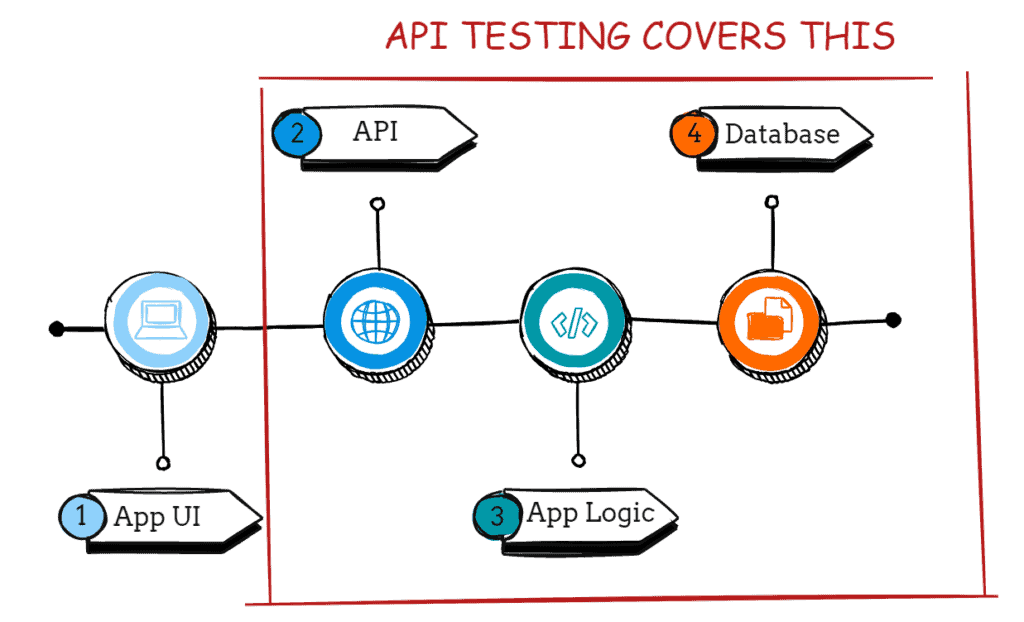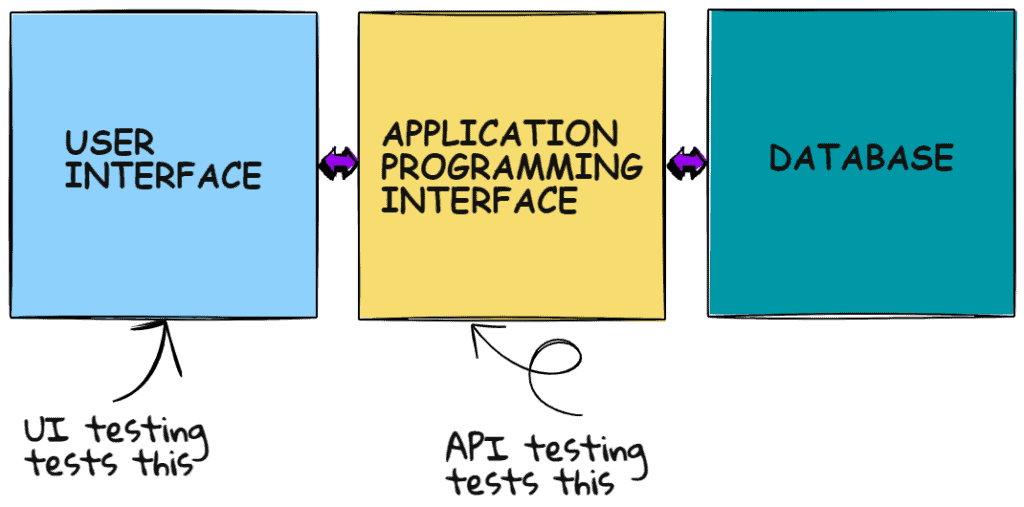When it comes to testing and quality assurance, people often get confused between API testing and integration testing.
Even though they might look quite similar, there are some key differences.
Integration testing is a type of software testing where different components and modules are tested together. API testing is a type of integration testing where you test the API of the system. API tests include testing of functionality, reliability, performance, and security of APIs.
This guide will cover everything you need to know about the differences between integration testing vs API testing. It starts with a basic understanding of both testing methods. Thereafter, you will also get a complete table of API testing vs Integration testing comparisons to understand the differences and similarities between these two.
Let’s begin with the overview.
What is integration testing?
An integration test is a part of software testing where different components and software modules are tested. The main goal of integration testing is to see if all the software components work together. Usually, integration testing comes after the completion of unit testing and before you do the end-to-end testing, also known as e2e testing.
The integration test checks if the interaction and interface between modules work as intended. However, the test case doesn’t have to be limited just to modules. You can do integration testing on many levels: The tests can be carried out between components, units, modules, or even parts of the system. The last type is sometimes also referred to as system integration testing.
Types of integration testing
There are several different types and approaches for integration testing:
- Top-down testing: As the name says, you need to start with the highest priority module and go to the lower module in the testing.
- Bottom-up testing: When lower modules depend on the higher module, a reverse approach is preferable.
- Big bang testing: Here, all the modules and components of the software system are integrated and tested as a whole.
- Sandwich testing: It’s a combination of a top-down approach and a bottom-up approach. The testing starts from both ends and moves toward the middle-level components.
- Agile testing: This is a common approach when the product is already out. The testing is performed throughout the development process. Usually, the developer runs the test cases as part of the regression testing step to ensure the new code doesn’t break the existing code.
- Continuous integration testing: Also known as continuous testing, it’s a method where you execute the integration tests as part of the Continuous Integration/Continuous Deployment (CI/CD) pipeline.
The integration test suite can check various things:
- Testing of the integration points between different modules or components.
- Data flow verification in all the modules.
- Testing of the interactions between different systems (such as databases, servers, and third-party APIs)
- Validation of interfaces and APIs.
- Error handling and fault tolerance mechanisms.
- Performance testing (load testing) to find out bottlenecks.
What is API testing?

API testing is another part of software testing where you test the Application Programming Interfaces (APIs) directly. If you are unaware of the APIs, it’s a component that allows you to communicate between the system to another application (usually a third party). The API usually represents the interface that separates outside API clients from the backend and database of the system.
Since API plays such a crucial role, it is essential to create API tests.
API tests include testing of functionality, reliability, performance, and security of APIs. Depending on the approach, you can carry out API testing at various stages and in different ways:
- Manual testing – QA specialist uses an API testing tool to manually check the API endpoints’ functionality.
- Automated testing – Developer writes and runs the API tests during development and runs them locally.
- Continuous testing – API tests are executed automatically in a CI/CD pipeline.
During API testing, you should take note of missing or invalid parameters during the calls, incorrect or unstructured data formats, wrong response codes, etc. In some cases, you also need to check the security vulnerabilities of the APIs. Today, most apps rely on APIs.
Therefore, it’s one of the important parts of software testing.
Methods of API testing
API testing has various methods. Here are some of the top methods:
- Functional testing: You check that each API endpoint produces the expected response based on a given request.
- Load testing: Applicable when there are a huge number of API requests. Load testing ensures that the app is stable even if there are a significant amount of queries.
- Fuzz testing: In fuzz testing, a random fuzz (invalid or random data) is given to all the APIs to test the error handling and uncover any security issues.
- Security testing: Authentication and authorization mechanisms should work properly. Security testing ensures the same.
- Regression testing: It’s the process of testing the APIs every time there is a new change. Testers and developers use it when the app is in production.
What does API testing include?
It depends on your application and development environment. These are the top things for API testing:
- Request and response validation
- Error handling
- Authentication and authorization
- Performance and load testing
- Security testing (such as SQL injection or cross-site scripting)
- Integration with other APIs or systems
- Concurrency and synchronization
- Parameter combinations and boundary values
- Caching and data consistency
- API versioning and backward compatibility testing
Is integration testing the same as API testing?
Even though they are not the same thing, API testing is a type of integration testing.
However, it is easy to confuse them as the core working of both tests is quite similar. Both tests ensure that different components integrate with the software and function properly.
But here are some key differences.
| API Testing | Integration Testing |
| Tests the functionality and performance of APIs. | Tests the interaction between different components of an application. |
| Automated testing performed early in the development cycle. | Testing performed after unit testing and before system testing. |
| Focuses on the behavior of the API for a given input. | Focuses on how different modules or services interact with each other. |
| Typically tests individual APIs in isolation. | Tests the parts of the system. It can check API, database, business logic, and integration with external resources. |
| Only usable for testing APIs that are part of a larger system. | Can be used for testing a wide range of applications, including desktop, web, and mobile applications. |
Let’s dive in deeper and see the similarities and differences between both of these testing.
API testing vs integration testing – further comparison
Integration test will include all the components and modules of the software, whereas API test only tests the application programming interfaces.
APIs require a higher level of the report to ensure the working.
There are various parameters you should keep in mind to test it. For instance, if your software interacts with third-party APIs, you need to ensure that proper security protocols are taken. In the same way, if the data is sent from your app to the system, you need to recheck the format and size of the data.
Use-case for integration test and API test
Let’s say your software development team has developed a shopping site, and you are testing it.
Your shopping site consists of several layers:
- User interface
- API
- Business logic
- Database
So, how to ensure the application is properly covered with tests?

Well, you can deploy different types of testing:
- Unit testing – you can start by writing unit tests for the business logic to ensure the business rules are implemented correctly.
- Integration testing – After you check the units separately, you can check if they are connected properly and function correctly in a bigger module. You can also write some tests to ensure the database operations work correctly.
- API testing – API integration testing includes running various queries and getting accurate results. The API should return proper results to make sure the cart and checkout modules work as expected. The API endpoints should have proper error handling and return with proper error codes in case of an error.
- UI testing – you can write UI tests using Selenium or some other similar tool to ensure the application works correctly end to end.
If you use all the tests above, you form a complete testing pyramid. And ensure the best code coverage for your app.
So, all the shopping site components should run properly. That’s the main aim of integration testing.
Comparing every aspect of API testing and integration testing
The table below shows various factors and how the testing methods differ from each other. The rest of the data is already covered in the above sections.
| Criteria | API Testing | Integration Testing |
| Definition | Testing the APIs directly and individually. | Testing functionality of all the components. |
| Scope of testing | Focused on individual APIs, their functions, and parameters. | Focused on testing the interactions between all the components, modules, APIs, and units. |
| Testing type | Black box testing | Gray box testing |
| Testing level | Usually performed at the API level. | Usually performed at the module or integration level. |
| Test environment | Requires a stable API environment. | Requires a stable integration environment for all the components and modules. |
| Test data | Uses a limited set of predefined test data. | Uses a more comprehensive set of test data. |
| Test automation | Can be automated using API testing tools. | Can be more complex to automate due to multiple modules. |
| Benefits | Helps ensure API reliability and functionality. | Helps ensure system integration and end-to-end testing. |
| Challenges | Can miss issues that arise from interactions between APIs. | Can be time-consuming and resource-intensive. |
| Examples of tools | Postman, SoapUI, REST-assured, Insomnia | Selenium, Appium, JUnit, TestNG |
Conclusion
To summarize, API testing is the test for APIs only, whereas integration testing includes testing all the possible integration on the software system.
API testing is a type of integration testing. The methods for testing and the testing scope will change depending on the software you are running and the development process.
This guide was to give you a complete idea about API testing vs integration testing.
